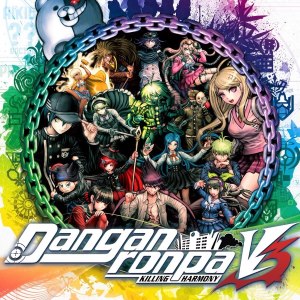
This is a weird one to explain. Here’s the premise: sixteen students in a high school wake up, and they can’t remember anything. They are trapped in a school, and told that the only way they can escape (graduate) is by killing a fellow classmate and getting away with it. Oh, and the one in charge of all this that explains it to you? A robot bear.
It’s weird, yes, but as soon as you start the game it doesn’t feel that weird given the heavily sourced anime art-style. Previous games in the series have contained lots of elements of different games, but in essence Danganronpa is a story driven game more closely connected to a visual novel than a classic-styled adventure game.
A lot of your time is spent reading story and interacting with fellow classmates. The game is split into chapters, and as you progress you will build relationships with each of your classmates (to varying degrees) but eventually, people will die. Then, it is up to you to try and figure out what happened by investigating crime scenes, participating in trials, challenging evidence and encountering all sorts of emotions and twists.
It’s hard to describe Danganronpa in words as you really need to play it to understand (or believe) it. As you get to each trial, a series of mini-games commence. The most frequent in Danganronpa V3 is a discussion between classmates where the words float around the screen in random directions and velocity. You need to shoot the correct phrase with a ‘truth bullet; to move the discussion on to the next topic. As tempers rise in the courtroom, more people speak and shout, so more words float around the screen, making this harder.
New to V3 is the ability to lie (or more properly, commit perjury). Do you lie because you know the real outcome but don’t have the evidence? Lying opens up new paths of dialogue but ultimately runs the risk of getting caught out. This is neat as it means there isn’t simply one path towards victory in each setting.
A game of this kind won’t work without a strong set of characters and Danganronpa has it in spades. Each segment where you get to explore is time-limited which does mean you have to pick and choose who you interact more with (so you will definitely develop some favourites). Each student is an ‘ultimate’ student, meaning that they have a specific field of study in which they are proficient. This influences their personality slightly and isn’t always what you expect. For example, the ultimate tennis player used his tennis skills to eliminate a gang, and become a convict and he talks about his life incarcerated. Weird, but then this is Danganronpa where nothing is truly that weird.
Characters are supported by humour, and boy is it funny in places. One of my favourite quips is when the bear disses one of the more popular NFL teams and lambastes that it is the season of a lower team. I take great delight in sending my screen capture of this to one of my friends every time he mentions said team. Some of the references are a little more obscure (I didn’t get many of the anime ones) but others are a little easier for typical Western audiences. The what Hedgehog??
If there’s one criticism it might be that the cases are probably not quite as eccentric as previous games, and the repetition of daily life in the school starts to bare some feelings of repetition in the series. Mysteries can feel a bit predictable and where the game hasn’t revealed the killer yet, you’re miles ahead and just waiting for it to catch up. This isn’t all, and doesn’t stop the entirety of Danganronpa V3 being an overall recommended experience.
Reviewed on PS4


Leave a Reply